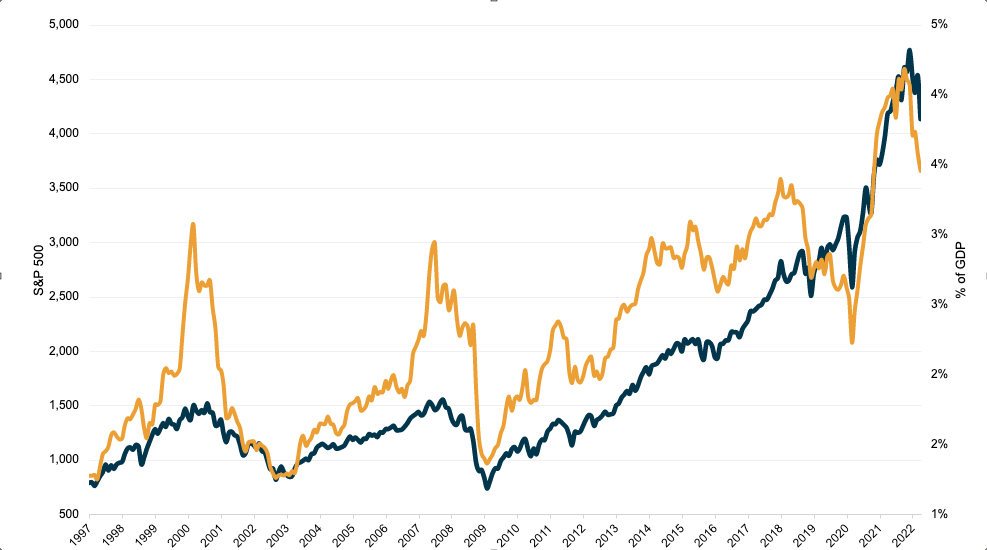The rise and fall of unprofitable tech
Last week saw the S&P 500 and NASDAQ break a streak of seven consecutive weeks of decline. It was the longest stretch since 2001 for the S&P 500 and 2011 for the NASDAQ.
Calendar year to date, the S&P is down 13%, while the NASDAQ has shed 23%. But headline indices always hide bigger stories, and we think the plight of unprofitable tech may have more chapters to come.
Unprofitable tech companies have borne the brunt of those headline declines, down 50% calendar year to date. In fact, almost 15% of stocks in Goldman Sachs’ unprofitable tech basket are down more than 70%.
This brings us to the once all-powerful global army of retail investors, that had previously supported markets, particularly unprofitable tech stocks, during market selloffs.
But ‘retail’ is only now starting to feel the pain of portfolio losses relative to February 2020 pre-COVID prices. May is the first month since the pandemic began that retail investors have been net sellers in the market and should this continue, retail-focused stocks will remain under pressure.
It should be remembered, retail investors piled into a rising market using leverage, and margin loans in the US reached record 4.5% of GDP at the end of last year. While this figure has fallen to c. 3.5% in recent times, this is still very elevated relative to history.
If margin calls are met with forced liquidation, we may not have reached the bottom yet.
Margin Debt versus S&P performance

But inflation, yields remain key to equity market preferences
Some have called ‘peak inflation’ after the March 2022 print, however even if inflation did peak in March, CPI remains meaningfully above the Fed’s 2% target, and history shows persistent inflation above 4% leads to demand destruction and multiple compression at the headline level.
While inflation has several puts and takes, it will pay to monitor the labour market which has been a key contributor to the inflationary pulse. Wages in the US have grown around 6% p.a. for some time now compared to just 3% p.a historically, due to a very tight labour market. The recent Job Openings and Labor Turnover Survey (JOLTS) indicated there are two job openings for every unemployed person in the US, which is unprecedented. The labour force participation rate still remains below pre-COVID levels.
A shortage of workers is also contributing to tight housing supply which is driving up rental prices, and rent is a meaningful contributor to inflation. Unlike Australia where variable rate mortgages dominate, mortgages in the US are fixed to 30-year rates. The increase from 3% to 5.25% in recent months has taken the heat out of new sales, but it will take time for this to wash through to the rental market.
As we continue to see a full reopening from COVID lockdowns, goods inflation has slowed but services inflation is accelerating. This has been driven by both supply and demand factors as consumption naturally shifts away from goods to services as people are able to move around. This is likely to remain elevated as we head into northern hemisphere summer.
All of this highlights the delicate position the Fed is in.
Even if growth slows, interest rates are a very blunt tool; aggressively hiking short term rates will intensify any economic slowdown without necessarily addressing inflation. Short term rates don’t address supply side issues. Changes in the labour market, however, will be key as looser conditions can act as a release valve.
And even if inflation does cool the starting point is extremely elevated conditions, and the Fed has been very clear its primary goal is to fight inflation. We see rates rising and balance sheet tightening continuing at the current pace unless a meaningfully more stressed economic scenario emerges. Softer inflation, however, may mean the Fed doesn’t need to hike as aggressively as the market has forecast, which can have implications for equity market preferences given the brutal selloff in certain pockets of the market.
Multiple dispersion remains elevated
Despite the extreme moves over the last two months, low multiple - or Value - stocks are still cheap relative to high multiple - or Growth – stocks.
The chart below depicts multiple dispersion. It’s the valuation of low multiple stocks in the market relative to high multiple stocks, and low multiple stocks are still more than 30% cheaper than high multiple stocks compared to a long-term average of 20% cheaper.

Source: Factset and Antipodes, as at 30 April 2022.
Higher yields/discount rates will see investors exercise more discipline around valuations especially compared to recent history. But that doesn’t mean every low multiple company is attractive, especially in the current economic climate.
With the onset of war in the Ukraine, our base case shifted to stagflation and we reduced the cyclical tilt in the portfolio – and in a backdrop of stagflation investors need to be selective.
A weak economic environment is challenging for weak cyclicals just as much as high inflation and high discount rates is challenging for weak growth. The prospect of stagflation has led to a correlated drawdown between bonds and equities, and within equities.
Despite these challenges we’re finding opportunities.
As a pragmatic value manager, we don’t buy stocks just because they are on low multiples. We look for resilient businesses that are cheap relative to their growth profile - market leaders that can take profitable market share in a backdrop of higher inflation and will be better positioned to weather a tougher economic environment. And we are disciplined around valuations.
We cannot ignore the dislocation in the tech/growth complex. Not all growth stocks are genuine disruptors, and we avoid weak companies regardless of whether they have a cyclical or growth profile. However, with the NASDAQ in bear market territory there will be category leaders that are falling to attractive valuations relative to their long-term growth profile.
These companies do have a place in a pragmatic value portfolio
Stock in focus: Merck & Co (NYSE: MRK)
Leading pharmaceuticals company, Merck, is a quality defensive business that isn’t facing the same inflation pressures as other defensive parts of the market.
Almost one-third of the company’s earnings are generated from vaccines and animal health, which have high barriers to entry, consolidated market structure and as a result higher profitability relative to traditional drug development.
Merck manufacturers the HPV vaccine Gardasil which has been proven to prevent a variety of cancers and has long runway for growth, and the animal health business has high brand equity particularly amongst herd animals.
In terms of its pharma business, Merck’s Keytruda is the most successful immuno-oncology drug globally. Whilst the patent cliff begins at the end of 2028, Merck is preparing itself via combination studies with next generation immuno-oncology drugs which could extend Keytruda’s dominance, internal pipeline development via its own R&D engine, and the company has ample balance sheet capacity for acquisition.
Merck is valued at around 12x earnings with earnings growing around 12% p.a.
An unconstrained approach to global equities.
We are pragmatic value investors who have developed an eclectic process in building high conviction portfolios of global companies. To learn more, please visit our website.
1 stock mentioned

